|
Every spectator entering the San Francisco opera house without a proper mask was handed a
brand-new, sterile N-95. Vaccinations and boosters were checked. SF Ballet bravely opened its 2022 season with Balanchine, Tomasson and a world premiere, Cathy Marston's Mrs. Robinson,
a danced version of the 1967 movie The Graduate by Mike Nichols. The house was packed and expectations were high on both sides of the orchestra pit. One felt for the
dancers who had trained and rehearsed for months under masks. They seemed released and unleashed in all their splendor while we, the audience, were sitting at attention in
our square-shaped N-95 masks like a pack of eager bulldogs and pigs.
Trio
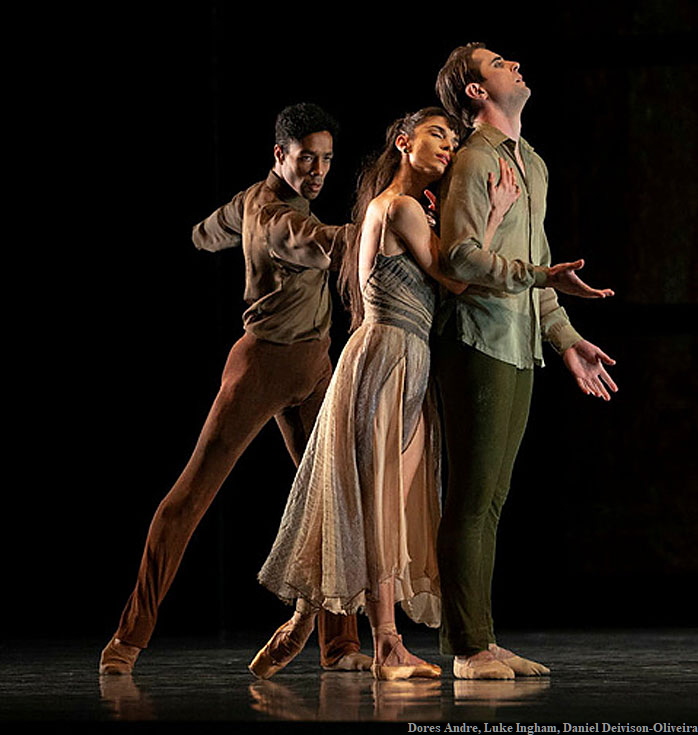
The 2022 season carries the final stamp of departing artistic director Helgi
Thomasson, who sent almost the entire company out to gambol onstage in Program 1.
The evening opened with the traditional Tomasson choreography. This time it was Tri (2011) to Tchaikovsky's Souvenir de Florence, a luscious
string sextet. The work for seven soloists and the ensemble is pleasing with its clean, crisp classical lines and an Adagio that veers into subtle story
-telling: the pas de deux of two lovers, touchingly danced by Elizabeth Powell and Henry Sidford, is joined by a stranger (Nathan Remez) who
gently imposes his rights to the woman. She keeps yearning for her lover but doesn't resist the pull of the mystery that might be death.
Symphony in C
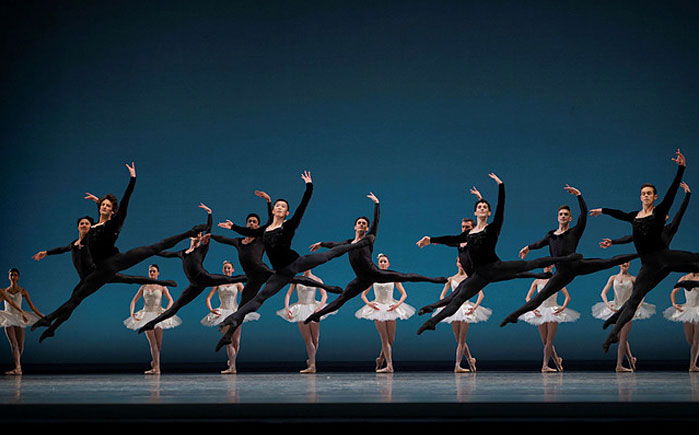
Balanchine's acclaimed Symphony in C to music by Bizet was executed
with verve by four principal couples, eight soloist couples and thirty-two corps women – the men in black leotards, the women all in glittering white
tutus (the original title of the 1947 piece had been Le Palais de cristal). It's a highly athletic, enthusiastic ballet asking the women to jump as much as
the men, and ending in a whirl of 66 dancers onstage in geometric formations at maximum speed. On YouTube you can see a performance of
the New York City Ballet in 1973, when the master, the legendary Mr. B, was still alive. The piece looks masterful indeed, and the effect of the
incessant leaps is heightened by the white socks the male dancers wear. As this perfection is out of reach nowadays, I enjoyed the whirl, felt grateful
for the approximate crispness and symmetry–and was thrilled to see one ballerina, Principal Dores Andre, dancing the Third Movement with the
full measure of musicality, speed and fluidity of phrasing that Balanchine demanded in order to "see the music and hear the dance."
Mrs. Robinson
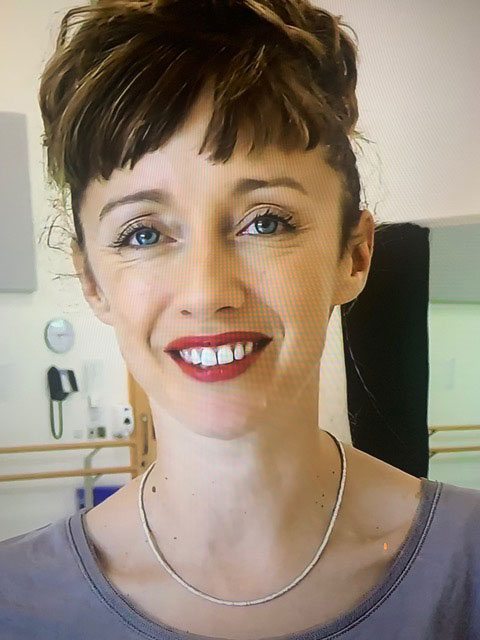
British choreographer Cathy Marston has been creating international buzz
with her story-telling ballets based on works of literature. From Wuthering Heights and Les Liaisons Dangereuses to Lady Chatterley's Lover and Lolita, the daughter of two English teachers has a knack for psychological,
character- and eros-driven narratives. Four years ago she enchanted SF audiences with Snowblind, her haunting rendition of Edith Wharton's 1911 novel Ethan Frome with its triangle of doomed lovers.
Tomasson had commissioned a new piece for the 2020 season, but Mrs. Robinson had to be postponed for two Covid years. All the audience got
was a teaser-trailer with the lead dancers: a bored, sophisticated lady (Sarah van Patten) sits on a café terrace with her husband (Luke Ingham)
and dreams up a fantasy of seducing a young guy (Joseph Walsh) off the street. The fantasy came across as a rather banal seduction pas de deux that
made my heart sink. I couldn't believe Marston would bother with such a conventional "illustration" of The Graduate.
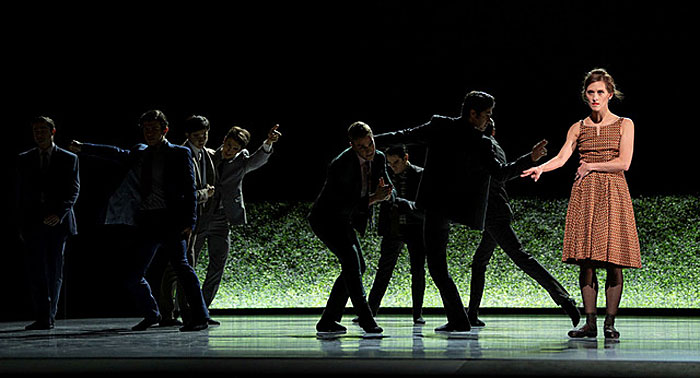
With the opening of the curtain, however, everything is unusual. The stage
is closed off at full length by a cardboard hedge, making me think of the border of a golf or country club or perhaps the more modish equivalent of
a picket fence. The regular tic-toc of a metronome seems to indicate time is running out. The score by composer Terry Davis (Shakespeare in Love)
sets in with a moody saxophone marking what may be the lullaby of the "innocent" sixties when "father knew best." A bedraggled teenager (Joseph
Walsh) stares at the lime-green hedge, perhaps pondering the demarcation line between now and whenever. A group of his pals appears and instantly
fascinates with movements that can't be placed in any precise dance tradition. There is classical precision and modern contortion, but it is
neither. Marston has invented a disturbingly and attractively ambiguous body language for her early 60s teenagers. They move with space-grabbing,
extremely wide steps and aggressive flailing of arms evoking the uncontrolled greed of youth. There are childish slapstick moments
recalling Punch and Judy shows or a burlesque cabaret. Sometimes the exaggerated, wide strides reminded me of Germany's (in)famous rhymed
storybook about badly behaved children, the Struwwelpeter or Shockheaded Peter.
Next come the girls, a troupe of little wind-up dolls in summer dresses,
exercising grace and charm with strictly controlled, unified gestures of what might be dusting or decorating the living room.
Aha, I thought -- the hedge may stand for the rigid barrier between
conventional male and female behavior. The mood is perfectly set for the frustrated, forty-something wife, mother, hostess, Mrs. Robinson. Danced
by Sarah van Patten, she appears at a garden party, bored, haughty, and bothered by her lusty, lumbering husband, Luke Ingham, who does a
marvelous act of being gross. Like a drunken bear, he keeps lunging at her, only to fall unconscious between her legs.
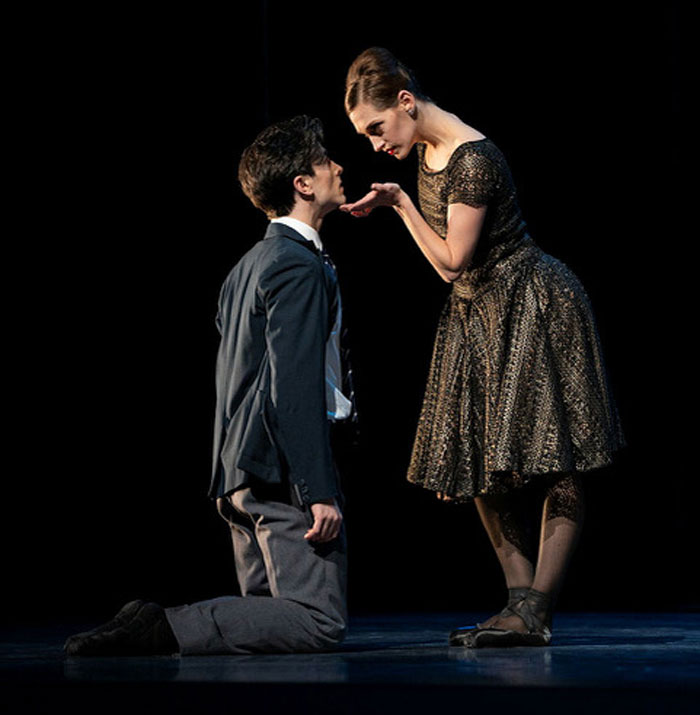
The social comedy evolves as Mrs. Robinson now picks out Benjamin, her
"graduate," and raises his befuddled head with the tip of her black point shoe. What follows elicited chuckles from the audience: the sexual
awakening of a reluctant novice, who bumbles, half asleep, half confused from one hilarious misstep to the next. When she peels him out of his
jacket and carries it out of sight, he runs after it in panic. He finds himself entangled with her on the floor and tries to get away by crawling through
her legs. Both van Patten and Walsh exhibit admirable acrobatics and comic timing in these sexy tumbles. When Mrs. Robinson finally manages
to "get" him and sits on his lap like a rider on a fallen horse, his upward-shooting leg supports her like the back of a chair, only to collapses all too
quickly with a plunk. Knowing laughter from the audience.
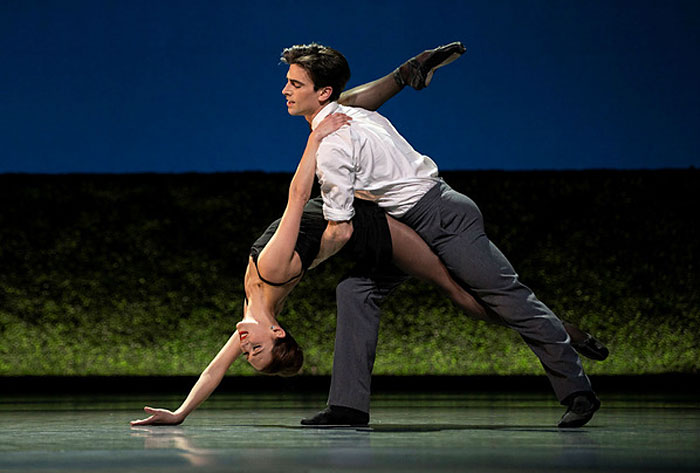
But with his considerable boyish charm, Walsh is not an innocent violet
being plucked and discarded. He gets a second chance and this time, he is more adult, more hungry, chasing, grabbing and lunging at her body across
the imaginary bedroom floor.
What does Mrs. Robinson get out of the clumsy frolick? Not much: like
Dustin Hoffmann's Benjamin in the film, this youngster is a lovable but somewhat hapless jerk. And naturally things don't get better when he falls for her daughter.
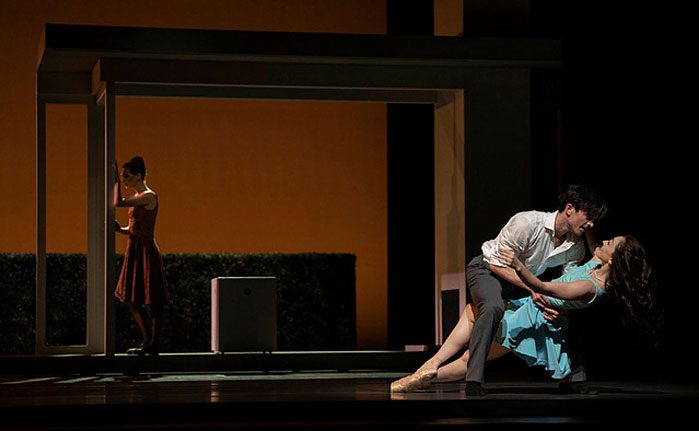
Up to this point I was fascinated by the way Marston delivered a multi
-colored character study of Benjamin's coming of age. A doubt crept in, however, when the choreographer suddenly turns him into Prince
Charnimg with a playful, tender "sweet sixteen" love duet with daughter Elaine (Madison Keessler). His rough experience with Mrs. Robinson
apparently hasn't left a mark. This choreographic "nicety" flattens the story and the ballet version falls back behind the bleak power of Nichols' movie.
Like falling dominos, another weakness reveals itself: What do we know about Mrs. Robinson that would make her the heroine of Marston's story?
Marston's Mrs. Robinson is still the same cold, alluring, dissatisfied wife
she was at the outset. If the movie doesn't reveal who she is, Marston's ballet doesn't either. She remains as abstract as the movie's nebulous
theme song by Simon & Garfunkel. The choreographer shows Mrs. Robinson refusing a final pleading embrace by her husband. She lets him
leave, just as she lets her young lover leave, without a tear.
The group of proper girls returns, again practicing ridiculous gestures of
"femininity" in daisy chains – each one eager to become the next Mrs. Robinson. Unavoidably, the German dance theater inventor Pina Bausch
comes to mind with her brilliant, mocking lines of women executing the stereotypical vocabulary of gender roles. Marston uses the idea
creatively–with the difference that her American girls don't flirt, provoke or seduce. Their proscribed role is all virginity, zero sexuality, please.
Mrs. Robinson stands alone, on the outside, finished with home and
husband. She watches the women's group loosen up and tentatively start to rock and roll. The repetitive tic-toc from the orchestra seems to mark the
new era, the year 1968. Mrs. Robinson easily joins the shimmy of the group for a moment. But instead of running offstage with them into the future,
she remains behind, pensive, undecided.
Suddenly behind the hedge, the heads of men pop up like targets in a
shooting gallery. They stay there, in suspense, safely ensconced behind their patriarchal property line. Mrs. Robinson seems to ask the audience:
What now? Should I shoot them down? Or am I the target? Are they going to mark me with the letter F as a traitor, a pariah? Or are they afraid of me,
barricading themselves against the coming onslaught of women's lib?
Marston had intended more for her heroine (who never had a name of her
own) and to be frank, I also expected more when I read that Marston wanted to accord Mrs. Robinson a "future." I thought she would perhaps be
more than a seductress without a heart. What if Mrs. Robinson would for the first time love somebody? Or fall in love?
Nothing really happens to her and that's too bad. Perhaps Marston didn't
find images for her heroine's liberation. So the story basically stays where the movie stayed. The allure of Anne Bancroft in the role made it easy to
imagine a future for her: anything post-divorce. Nevertheless, Marston achieved a lot with her funny, poignant psychogram of an era—the
oppressive, fake calm and sexual undertow of white suburbia before the revolution hit. And if not quite satisfying, it's a clever ending. Let the
audience decide what Mrs. Robinson's future holds.
Photos: Erick Tomasson
|